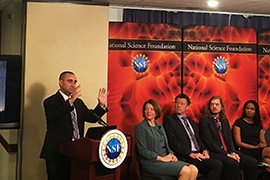- Slug: BC-CNS-Cosmic Crash,630
- Photos available (thumbnails, captions below)
By ISAAC WINDES
Cronkite News
WASHINGTON – It was what one scientist described as “a giant explosive train wreck that makes gold” in the cosmos, and a University of Arizona astronomer was one of the first to get a look – even though the actual event was more than 130 million years old.
David Sand, an assistant professor in astronomy at the University of Arizona, joined other scientists in Washington Monday to talk about the first evidence of a confirmed kilanova, the collision between two neutron stars.
According to the National Science Foundation, a neutron star crushes “half a million times Earth’s mass into a sphere about 20 kilometers (12.4 miles) across.”
The fiery collision between two dead stars creates massive amounts of gold and platinum, and sent out waves of gravity and light that traveled 130 million light years to make it to Earth.
Astronomers said the discovery is further proof of Einstein’s Theory of Relativity and is an important step forward for the young fields of multimessenger and gravitational-wave astronomy, which uses gravitational waves in addition to light waves to observe space.
Arizona State University astronomer Nathaniel Butler said Tuesday that the discovery is huge because it opens “this whole new window into the universe.” Butler said the discovery “proves the connection between gamma rays and gravitational waves.”
The explosion was first detected on the morning of Aug. 17 by the Laser Interferometer Gravitational-wave Observatory (LIGO), a facility split between Louisiana and Washington state, and its European counterpart Virgo. In the hours and days following, a select group of astronomers from around the world scoured the sky to find an electromagnetic counterpart, light, to the ripple of gravity.
The search for the kilanova’s waves was a collaborative effort that ultimately involved more than 3,000 participating scientists.
Scientists in the field made headlines last year when they provided the first proof of gravitational waves, a concept theorized by Einstein 100 years ago. Last year’s discovery earned scientists this year’s Nobel Prize in Physics.
The endeavor is one of the most expensive projects funded by the National Science Foundation, which invested about $1.1 billion in construction and upgrades in LIGO since 1990, according to a LIGO Factsheet.
National Science Foundation Director France Cordova said the discovery was already “transforming our understanding of the universe with a fresh narrative of the physics of stars in their death throes.”
The investment in LIGO found the explosion, but Sand said the ensuing search was possible even with relatively small telescopes like his, a 16-inch “souped-up amateur telescope” based in Chile but remotely controlled from Tucson.
“Even with our small telescope we could tell that this event was unique in nature,” Sand said.
Another scientist who was among the first to see the discovery was Andy Howell, a staff scientist at Las Cumbres Observatory, who described it as “the astronomical equivalent of stopping traffic – while we all stopped to go and get a look.”
“A long time ago, in a galaxy far, far away, two neutron stars merged together,” Howell said at Monday’s National Press Club event to talk about the finding. “But we only found out on earth on Aug. 17, right before the solar eclipse.”
Sand said that, based on the first episode, the collaboration “has a bright future.”
“We could detect this kilanova event even if it was twice as far away, with no adjustments to our program – small telescopes can still play a large role in the coming era of multimessenger astronomy,” he said.
Sand said that following this discovery, if LIGO and VIRGO wave readings are made public in the future “advanced amateur astronomers” could “participate in this great adventure.”
^__=
Web links:
_ LIGO Fact Sheet: https://www.ligo.caltech.edu/system/media_files/binaries/306/original/ligo-press-kit.pdf
_ NSF Press Release: https://www.nsf.gov/news/news_summ.jsp?cntn_id=243382&org=NSF&from=news
_ Nobel Prize: https://www.nobelprize.org/nobel_prizes/physics/laureates/2017/
_ Neutron star: https://www.nsf.gov/news/mmg/mmg_disp.jsp?med_id=75351&from=
^__=
University of Arizona astronomy professor David Sand with other scientists at a National Press Club event where they talked about the discovery of a kilonova, a massive collision of two neutron stars. (Photo by Isaac Windes/Cronkite News)
An artist’s rendering of a kilonova, the collision between two super-dense neutron stars that throws off huge amounts of gold and platinum, energy – and gravitational waves. (Photo by A. Simonnet courtesy NSF/LIGO/Sonoma State University)

